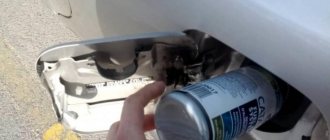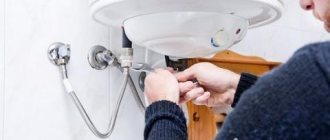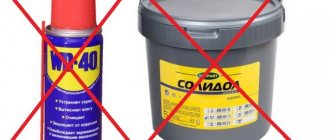An indirect heating boiler allows you to make maximum use of the heat produced by the heating system. Indirect heating of DHW systems is energy efficient and economical, which is why such units are becoming increasingly popular. However, like any other heat exchange equipment, such boilers are susceptible to the formation of corrosion, scale and blockages. To prevent this and ensure long service life of the equipment, it must be cleaned regularly. On the HitEnergy website you can buy a highly effective boiler flushing product at an attractive price.
How to drain water from an Electrolux boiler?
The Electrolux water heater must be drained in accordance with the following sequence:
- Shut off the supply to the container.
- Open the hot water tap.
- Unscrew the drain knob on the safety valve.
- Drain the water from the tank through a pre-prepared hose connected to the drainage hole.
Interesting materials:
Why is it difficult to hear on a mobile phone? Why doesn't it see it when I connect my phone to my computer? Why did the sound disappear on my Samsung phone? Why won't my phone charge? Why doesn't my phone read the memory card? Why doesn't my phone accept Wi-Fi? Why doesn't my phone see the flash card? Why can't my phone see the flash drive via the otg cable? Why can't my phone see my Android memory card? Why doesn't my phone see the microsd memory card?
What is meant by flushing heat exchange equipment?
Chemical in-place flushing of the boiler involves pouring a cleaning composition into it, which destroys accumulated deposits. The basis of the process is circulation. It is necessary not only for the effective removal of crushed deposits, but also for reducing the washing time.
If you simply pour the flushing liquid into the circuit and leave it for some time, it will quickly go from acidic pH to neutral, since chemical reactions will take place inside between it and the deposits. Because of this, only part of the contaminants will be removed and time will be lost for repeated refilling of the product.
By connecting a pump that provides circulation, the operator, who monitors the pH, can always add concentrate on time without temporary downtime. The cleaning solution continuously moves through the flushing circuit and enhances the effectiveness of deposit removal due to the hydraulic cleaning effect. Thus, when choosing the right product, it takes about 4-8 hours to wash industrial units.
Expert advice
In order for you to be able to use your boiler longer, you need to adhere to several rules that will help you not destroy the device ahead of time.
Buy a water purification filter, which comes in two types:
- the reagent filter is based on chemicals that oxidize iron, manganese and hydrogen sulfide, thereby softening the water;
- a reagent-free filter converts substances into an oxidized form, which makes it possible for them not to settle on the surface; therefore, it is more expensive.
And a few more tips:
- change the anode regularly;
- use maximum temperatures to eliminate bacteria;
- to remove an unpleasant odor, pass its full volume through the tank once every two months;
- use a scale filter.
Boiler selection
Let's try to find the right option together. If you need to purchase a water heater for the kitchen and use it for washing dishes and cutlery, a volume of 10-15 liters will be enough for you so as not to heat water that we do not use.
For one person, 50-80 liters of water is enough, but a family will need a 100-liter model. The size of the room is also of great importance; if it is small, immediately discard the “pot-bellied” options.
Cleaning a boiler without outside help is not at all difficult, but still, do not forget about the consequences, since cleaning too late will bring you many complications. Another thing is if you carry out this procedure once a year, then your equipment will last a long time and you can save your money and time. Successful use and long service life!
You can find out step-by-step instructions for cleaning the boiler yourself by watching the video below.
What to wash with
The HitEnergy company offers effective budget products from the GTphos line for washing heat exchange equipment. They are not inferior in quality to foreign analogues, but cost 3 times less. For indirect heating boilers, only GTphos Universal is suitable. This product perfectly removes deposits, even very old ones, without damaging metal surfaces. It comes in a concentrate form that is easy to transport and store.
Flushing the boiler with acid without special additives is extremely undesirable, since this method will lead to the formation of corrosion spots on the metal and increased wear of the equipment.
What is included in GTphos Universal
The exact composition of the product is not disclosed, as it is a trade secret. But the manufacturer indicates that the basis of the product is orthophosphoric acid, supplemented with complex organic acids, highly effective corrosion inhibitors and surfactants. Attention is also drawn to the fact that the composition includes a small amount of hydrochloric acid - no more than 2%.
What deposits can you get rid of?
GTphos Universal is designed to remove inorganic contaminants, such as:
- ● scale;
- ● corrosion deposits;
- ● inorganic pollution.
In addition to effective cleaning, the product leaves a protective film on metal surfaces, which prevents the formation of deposits for a long time.
Main advantages
GTphos Universal flushing fluid:
- ● energy efficient - removes deposits in a short time;
- ● disposed directly into the sewer with minimal treatment;
- ● safe if the rules of use are followed;
- ● carefully removes dirt without damaging metal surfaces;
- ● has a long-term passivating effect.
With it, even flushing a 200 liter indirect heating boiler will take place in a short time and without difficulty.
How is washing done?
The cleaning concentrate is diluted in the required ratio with water and poured into a special container from which it will flow into the boiler. In this case, a pump is connected to the flushing circuit, which will maintain the circulation of the product for the required time.
During the washing process, it is very important to maintain the pH value at the desired level - the effectiveness of cleaning depends on this. For this:
- ● before pouring into the boiler, the pH of the solution should be brought to a value of 1 - to do this, you simply need to add concentrate if the initial dilution did not give the desired result (pH is measured either with special portable devices or using indicator paper);
- ● after about half an hour, you should measure the pH of the liquid again - usually it approaches neutral or alkaline values, as the product reacts with deposits;
- ● the solution should be brought back to pH = 1;
- ● repeat the previous steps until the pH of the liquid remains at the same level - this will mean the end of the chemical reactions occurring inside.
After use, the liquid for flushing the GTphos boiler can be disposed of in the sewer, but it must first be diluted with a large amount of water; the boiler itself must be filled with water 2-3 times to flush the product. For greater reliability, you can use a special neutralizer, which is also available in the GTphos line. After all operations, the unit is filled with water and preserved.
What is the result
After properly flushing the boiler, the heating temperature is restored. For example, before washing the GTphos Universal, the unit was heated to 40 °C, which did not meet the technological requirements of the enterprise; moreover, maintaining operating parameters required greater energy consumption. Chemical washing was carried out and as a result the heating temperature increased to 55 °C.
Evaluation of indirect water heaters
In the modern world it is very difficult to do without hot water, so most people use boilers.
In stores you can find different types of water heating devices. They come in the following types:
- electric boilers;
- boilers; indirect water heaters;
- gas boilers;
- those that are heated by solar heat.
In this video you will learn how to make a boiler with your own hands:
To heat water in an indirect water heater, you do not need to use gas, electricity or solid fuel. The basis of the manufacture of a hand-made water heater is the use of thermal energy, which is produced by third-party sources. Due to transition heat transfer fluids, heat transport is necessary. Such substances can be antifreeze or water. By using a boiler, you can save a lot of energy resources.
Unfortunately, a water heater has a significant disadvantage: it is not possible to use it at the end of the heating season. Using a boiler during the hottest periods of the year only to obtain hot water is considered an economically unprofitable action. In this case, it is rational to make a combined water heater with your own hands, which, in addition to the heat exchanger, will also be equipped with a powerful heating component.
Elimination of external causes
But let's start in order. There are three ways to eliminate the smell of hydrogen sulfide that is not caused by the water heater:
- Deepen a well or well and take water from another horizon.
- Install appropriate filters at the entrance of the water supply system to the house.
- Contact the housing and communal services service or water utility, which should be responsible for the quality of water supplied to your home.
The first two points depend solely on you, but you can wait quite a long time for a reaction from utility companies, because they have this habit of blaming their problems on the lack of funding, inaccessibility of materials, and so on and so forth.
Do-it-yourself cleaning of water heaters from odor inside
Many owners of water heaters notice over time that the heated water begins to smell terribly. This unbearable smell may have several reasons:
- Dirty water is supplied to the boiler. If there are a lot of foreign impurities in the water, especially hydrogen sulfide, it emits an unpleasant odor.
- There are specific bacteria and fungi in the tank. Such living creatures are born in the limescale deposits on the walls of the container. As long as there are not many microorganisms, the smell of the water does not change. But over time, their number increases, and the water begins to stink.
- Cheap or damaged water supply. Low-quality tubular plastic transfers its chemical smell to water. And old metal water pipes are ideal for the life of bacteria and fungi.
Water with hydrogen sulfide is impossible to smell
There is a way to determine which of these cases occurs:
- Run cold tap water for 5 minutes. Then place a clean bottle under the stream and close it after filling. After half an hour, you need to open the bottle and check the smell of the water. If it smells bad, there is a problem with the pipes or water.
- If cold water from a bottle smells normal, you need to look for the reason in the boiler itself. To do this, you again need to fill the plastic container, but only from the hot tap closest to the water heater. We wait 30 minutes and smell. If you can’t breathe from the bottle, it means there are harmful microorganisms in the tank.
In order to eliminate the unpleasant odor due to bad water or rusty pipes, you can do the following:
- Install a filter that removes bad-smelling gases from the water.
- Complain to the SES about the poor quality of tap water.
In the first case, you don’t have to wait for someone to come and fix the problem. Therefore, if you can’t stand the smelly water, it’s easier and faster to install a filter.
Problems with microorganisms in the boiler are solved differently:
- Sterilization of the tank. The water in the boiler is brought to a boil and remains in this state for a long time.
- Removing scale from a water heater (see above). This will destroy the favorable environment for the proliferation of microbes and bacteria.
To prevent smelly water from coming out of the boiler again, you need to follow simple preventive measures:
Do not leave water in the water heater when it is not in use for a long time. Periodically descale the tank. It is advisable to install a filter
Pay attention to water quality. If necessary, contact the sanitary and epidemiological station
Bacteria reproduction
Microorganisms multiply if the boiler is rarely used, or if it operates in an economical mode (i.e. heats to 55-60°C). They release waste products, which causes an unpleasant odor. Most often rotten or rotten.
How to remove the smell from the boiler in this case? Warm up the equipment and drain the water. You may need to repeat this procedure a couple of times. If it doesn’t help, then you need to flush it. And if even then the smell does not disappear, then that is not the problem.
With collection
If scale has densely covered the heating element and the inner walls of the device, you will have to disassemble the device. To work you will need a tool:
- screwdrivers: slotted, Phillips;
- wrench;
- cleaner;
- sandpaper;
- screwdriver
It is advisable for two people to dismantle the boiler. The tank of the device is quite heavy, so cleaning it alone can lead to injury or damage to parts if it accidentally falls. When using chemicals, hands must be protected with gloves to avoid burns. It is also necessary to protect the respiratory system from volatile acid vapors.
https://www.youtube.com/watch?v=Ap2q97C4Z0E
Before cleaning, the boiler is disconnected from the network and the water is drained:
- First, turn off the water supply taps in the apartment.
- Then turn off the cold water supply valve leading to the boiler.
- Connect a hose to the hot water fitting and drain the contents of the heater into the sink.
- Next, remove the bottom panel of the device.
- Disconnect the wiring. Before disconnecting the wires, they are photographed so that they can be reconnected correctly.
- Unscrew the bolts and remove the heating element. To do this, first unscrew the nuts holding the bar.
- Place a basin under the boiler to drain the remaining liquid. Then the heating element is pushed up and removed. Sometimes the build-up on the part is so large that it does not fit into the hole. In this case, you need to carefully use a knife to remove some of the scale.
In some models of water heaters, the fastening screws are covered with a plastic panel with clamps. The panel is pryed off with a screwdriver and removed.
The heating element removed from the tank can be cleaned in two ways:
- Mechanical. This method is suitable if the plaque is loose. It is removed with a knife, then cleaned with sandpaper. Do not rub the heating element with increased force. If the surface layer is severely damaged, the part will fail and will have to be replaced. You need to remove scale from the heating element while it is still wet. Dried deposits are much more difficult to scrape off the heating tube.
- Chemical. The heating element is placed in a descaling solution, having first removed the thickest layer of scale from it. For immersion, it is convenient to use a plastic bottle with a cut off neck. The cleaning solution is poured into the bottle and the heating element is lowered for several hours.
We suggest you familiarize yourself with How to clean a bathtub from yellow deposits at home
At the same time as the heating element, the water heater tank is cleaned. When the tank is hung low, it can be washed without removing it from the wall. If the body is removed, it is placed upside down in the bath.
- If the scale layer is small, it is enough to wash the walls with a soap solution and then with clean water.
- Heavily contaminated internal surfaces are treated with chemicals or folk remedies.
- An effective and at the same time safe for metal product is a solution of citric acid.
- They fill an inverted tank with it for 10–12 hours.
- Then the solution is drained and the tank is washed with clean water.
- After cleaning, the device is reassembled in the reverse order.
- Rubber seals are coated with sealant before assembly.
- If the seals are damaged, they are replaced with new ones.
- After installing the heating element in place, the boiler is attached to the wall and connected to pipelines and electricity.
The inside of the tank is covered with enamel, so it cannot be cleaned with metal brushes or aggressive chemicals. Such treatment will lead to a violation of the tightness of the tank. If the enamel layer is already destroyed, the damaged area is cleaned with sandpaper and treated with an anti-corrosion compound or regular enamel.
Completeness
In a dual-circuit system, everything is there.
As a rule, a double-circuit floor-standing gas heating boiler is already equipped with everything necessary: a circulation pump, a safety valve, a membrane expansion tank and fittings. All that is needed to install such a mini-boiler room is to supply gas, water pipes and a pipe for removing combustion products.
In single-circuit - everything is separate.
Not only do you need to buy additional equipment, but you also need to install it in a boiler room, which requires a considerable area. Wall-mounted single-circuit boilers are more convenient in this sense - they already have some of the necessary components, all that remains is to connect a water heating boiler for the hot water system with protection elements.
Single-circuit.
You need space - both for the boiler itself and for the expansion tank, pump, safety valve. Considering not only the dimensions of the system, but also its unaesthetic appearance, it is better to place it away from the eyes. At the same time, the installation itself of both boilers will not be difficult for a good specialist.
Article Rating
What to consider
In indirect heating boilers, a magnetic anode is installed. If the unit is about 2-3 years old or less, then you should remove this anode, place a plug in its place and only then start washing. If the device is older, then the anode in it most likely dissolved on its own, so no additional manipulations are required when washing.
Before cleaning, supply and exhaust ventilation should be provided, since the reaction between deposits and the product occurs with the release of large amounts of carbon dioxide.
The product does not cause serious chemical burns, but can lead to irritation of the skin and mucous membranes. Therefore, operators should use standard PPE (gloves, goggles and overalls). If the liquid does get on the skin, it should be wiped with a cotton swab dipped in a soda solution, and then washed well with soap and water.
Be careful - Chinese phenol!
If the hot water from the boiler smells of gouache, anise, plastic, or medicine, it’s time to sound the alarm. Most likely there is phenol or formaldehyde in the water. These substances are dangerous to health; in small doses they lead to headaches and sleep disturbances. And in large cases - to serious poisoning and disturbances in the functioning of internal organs
Phenols and formaldehyde are most often released by low-quality plastic from which water pipes are made. Unfortunately, the only way to get rid of it is to completely replace the hot water pipe system.
Some cheap manufacturers make the storage boiler tank from plastic. It can also release harmful substances when heated. In this case, everything is also regrettable - it is necessary to change the boiler. No filters will help against phenols and formaldehyde.











